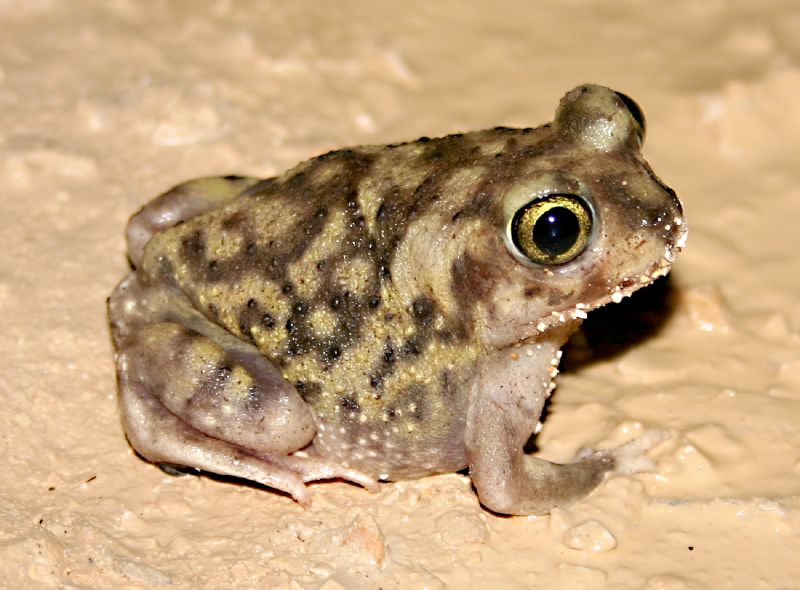ERROR : Server Busy(-1105)
ERROR : Server Busy(-1105)
Couch's Spadefoot Toad (Scaphiopus couchii) - Wiki
Couch's Spadefoot Toad
From Wikipedia, the free encyclopedia
[Photo] Couch's Spadefoot Toad (Scaphiopus couchii), Amistad National Recreational Area, Del Rio, Texas, USA. Date 2005-07-28. Author Clinton & Charles Robertson (http://www.flickr.com/people/dad_and_clint/) from Texas, USA.
The Couch's Spadefoot Toad, (Scaphiopus couchii) is a species of North American spadefoot toad (family Scaphiopodidae) native to the southwestern United States and the Baja region of Mexico. The epithet couchii is in honor of American naturalist Darius Nash Couch, who collected the first specimen while on a personal expedition to northern Mexico to collect plant, mineral and animal specimens for the Smithsonian Institute.
These toads can be found throughout the Sonoran Desert, including Arizona. How can you tell the species? True toads have horizontal pupils but the spadefoots have vertical pupils (like cats). Look at the sole of a hind foot. There you'll find the hard, dark "spade" that gives a spadefoot its name. There are only two spadefoot species in the Sonoran Desert of Arizona and California. If the space is sickleshaped, it's Couch's spadefoot, Scaphiopus couchi. If the spade is rounded, it's the western spadefoot, Scaphiopus hammondii(called the southern spadefoot, Scaphiopus multiplicatus, in some field guides).
Incidentially, the spades really are digging tools--spadefoots use them to burrow backward into the soil.
Once you've finished checking the animal, gently put it down where you caught it--it has important things to do--then wash your hands thoroughly in the water. Amphibian skin secretions can be quite toxic; they probably won't affect your hands, but you won't want to get them in your eyes, nose, or mouth.
Spadefoots live for the monsoon. They spend the rest of the year underground awaiting their wake-up call: the drumming of raindrops on the soil during a summer thunderstorm. As soon as the males dig out they go looking for rain pools, and when they find them they broadcast the news loudly as they can. The chorus draws silent female spadefoots from far and wide.
Mating is an urgent matter for spadefoots. Their tadpoles must hatch, grow, and change into toadlets before the pool evaporates in the summer sun. That's why they do most of their mating the first night the pool forms. Couch's spadefoot toadlets sometimes leave the puddle only nine days after the eggs are laid! Western spadefoots take longer--at least three weeks.
The warmth of the water speeds up the tadpoles' growth. Meanwhile they devour everything even remotely edible. They scrape algae off rocks. They filter microorganisms from the water as they pump it over their gills. They gather in wriggling masses, stir up the muck on the bottom of the pond, and filter that. And unlike most tadpoles, which are exclusively herivores and filter-feeders, spadefoot tadpoles are omnivores. They also eat dead insects and tadpoles, and they prey on fairy shrimp.
Western spadefoots go a step further. If the puddle is crowded and prey is abundant, a few of the tadpoles change into oversized, voracious carnivores These even go after other tadpoles. They prefer different species, but they'll eat their own kind, too--bad news for their relatives, but it gives the cannibals a critical advantage in the life and death race against evaporation.
http://en.wikipedia.org/wiki/Couch%27s_Spadefoot_Toad
| The text in this page is based on the copyrighted Wikipedia article shown in above URL. It is used under the GNU Free Documentation License. You may redistribute it, verbatim or modified, providing that you comply with the terms of the GFDL. |
|

